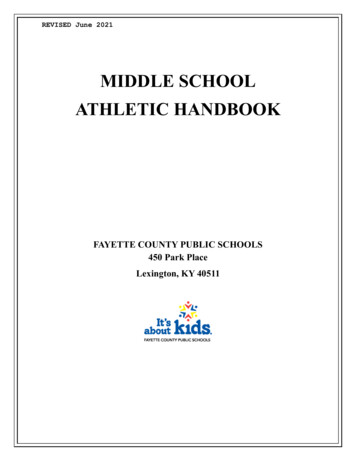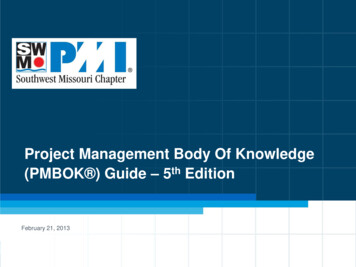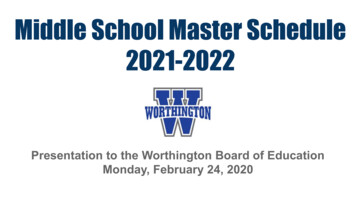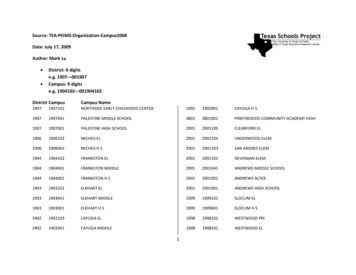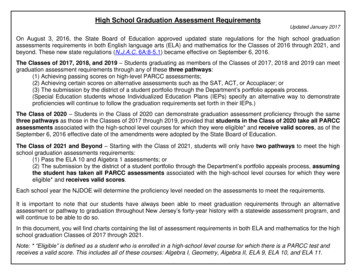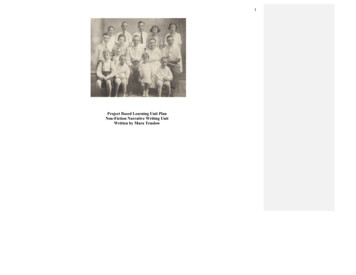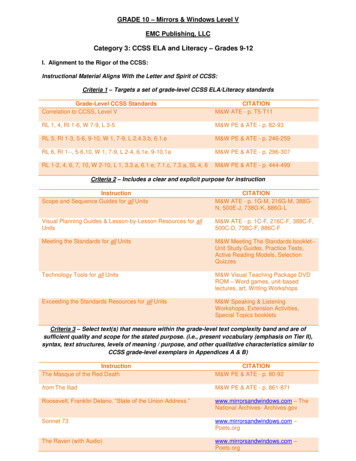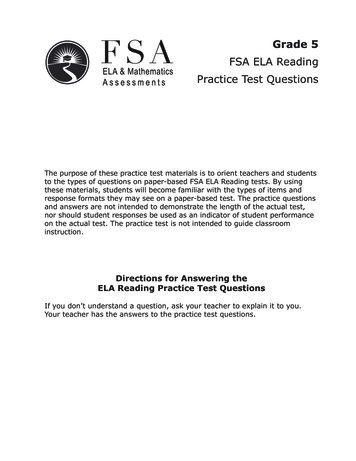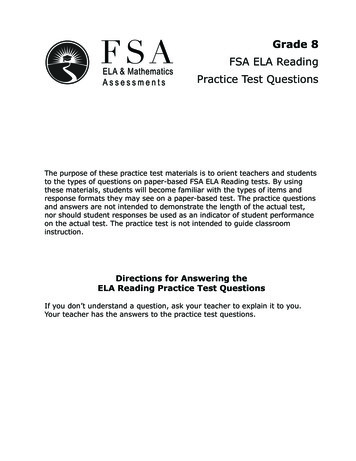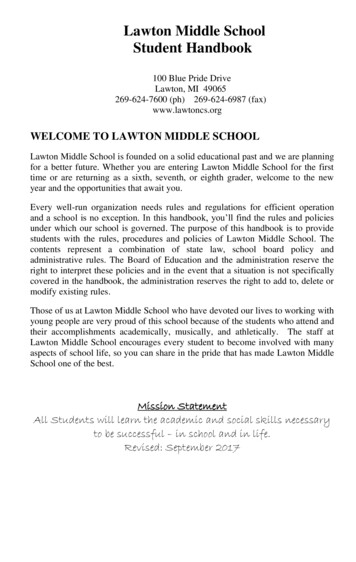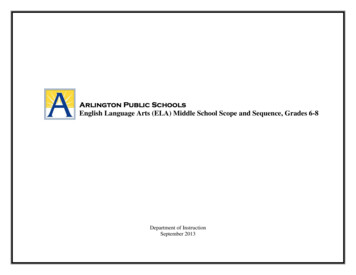
Transcription
Arlington Public SchoolsEnglish Language Arts (ELA) Middle School Scope and Sequence, Grades 6-8Department of InstructionSeptember 2013
Arlington Public SchoolsEnglish Language Arts (ELA) Scope and Sequence, Grades 6-8PurposeThe English Language Arts Middle School Scope and Sequence serves as an instructional guideline to align classroom instruction withthe English Standards of Learning across Arlington Public Schools. Following the common scope and sequence will establishconsistency of instruction throughout the district by providing clear guidelines on what students must know and be able to do in orderto become proficient in reading and writing. This consistency benefits students, specifically those who move within the schooldivision, and also teachers. A common scope and sequence will provide opportunities for collaborative planning among teammembers and allow for focused professional development.The sequence established is designed to support the cycle of planning, assessment and instruction for classroom instruction as well asto inform instruction in intervention and enrichment settings. Further, it is written to support teacher planning and collaboration.Format of the ELA Scope and SequenceThe English Language Arts Middle School Scope and Sequence provides a quarterly pacing guide for grades six through eight. Thedocument focuses on the reading and writing strands of the English Standards of Learning. At each grade level there are somestandards that are expected to be taught throughout the year, as well as specific standards to be taught during each quarter. In thisdocument, all of the grade level standards are directly taught during the first three quarters of the year to allow for review, application,and extension during the fourth quarter.Tools for TeachersThe ELA Middle School Scope and Sequence provides a road map for the explicit instruction of reading and writing in ArlingtonPublic Schools. Additionally, quarterly checklists have been provided for teachers to support deliberate planning.Formative Assessment CycleArlington Public Schools will implement a cycle of ongoing formative assessments in language arts using the Interactive Achievement(IA) system that are aligned with the English Language Arts Middle School Scope and Sequence, Grades 6-8. The followingassessments will be administered: beginning-of-the year diagnostic assessment, quarter 1, quarter 2, quarter 3, and the end-of-yearStandards of Learning Assessment. The IA assessments will be computer-based and reflect the format of the Standards of Learningassessments. Use of student achievement data from these assessments will support teachers’ knowledge of their students’understanding of the skills that have been taught each quarter. The data will inform decisions related to re-teaching and enrichmentopportunities. The extensive data provided (i.e., individual student, class, grade, strand, item analysis) will also support collaborationin data analysis and instructional planning.
The English Language Arts office is available to support schools in the implementation of the English Language Arts Middle SchoolScope and Sequence and the ongoing formative assessments for the purpose of student learning.Special ThanksThe ELA Office would like to thank the curriculum development committee, who reviewed scope and sequence documents fromsurrounding localities, learned to utilize Interactive Achievement, researched VDOE and other related resources to compose the APSEnglish Language Arts Middle School Scope and Sequence, Grades 6-8. Special thanks also belong to the administrators and teachersat Swanson Middle Schools for field-testing the quarterly assessments.Curriculum Committee MembersDr. Michelle Picard, Supervisor, English Language ArtsDr. Teri Adkins, Specialist, English Language ArtsGayle Kelley, ELA Reading SpecialistPaula Lamina, ELA Secondary SpecialistJohn Stewart, Grade 8 Teacher, Gunston Middle SchoolDinorah Macelwain, Middle School Reading Teacher (MSRT), Gunston Middle SchoolJennifer Dodd, Middle School Reading Teacher (MSRT), Williamsburg Middle SchoolNicole Goerss, Middle School Reading Teacher (MSRT), Swanson Middle SchoolSherilyn Wall, Grade 7 Teacher, Williamsburg Middle SchoolHeather Martin, Grade 7 Teacher, Williamsburg Middle School
The ELA Scope and Sequence introduces the explicit instruction of each standard in the first three quarters. Standards for reading and writing that are taughtthroughout the year are listed on the first page of this document. Subsequent pages denote which reading and writing skills and strategies are explicitly taughtduring that quarter. This allows for an integrated review in the fourth quarter. It is the expectation that these skills will be reinforced after they have been taught.Reading Standards Taught throughout the YearReading Standards Taught throughout the YearGrade Six6.4 The student will read and learn the meanings ofunfamiliar words and phrases within authentic texts.a) Identify word origins and derivations.b) Use roots, cognates, affixes, synonyms, andantonyms to expand vocabulary.c) Use context and sentence structure to determinemeanings and differentiate among multiple meaningsof words.d) Identify and analyze figurative language.e) Use word-reference materials.f) Extend general and specialized vocabulary throughspeaking, listening, reading, and writing.6.5 The student will read and demonstrate comprehensionof a variety of fictional texts, narrative nonfiction, andpoetry.a) Identify the elements of narrative structure,including setting, character, plot, conflict, and theme.b) Make, confirm, and revise predictions.c) Describe how word choice and imagery contributeto the meaning of a text.d) Describe cause and effect relationships and theirimpact on plot.e) Use prior and background knowledge as context fornew learning.f) Use information in the text to draw conclusions andmake inferences.g) Explain how character and plot development areused in a selection to support a central conflict orstory line.Grade SevenReading7.4 The student will read to determine the meanings andpronunciations of unfamiliar words and phrases withinauthentic texts.a) Identify word origins and derivations.b) Use roots, cognates, affixes, synonyms, andantonyms to expand vocabulary.c) Identify and analyze figurative language.d) Identify connotations.e) Use context and sentence structure to determinemeanings and differentiate among multiple meaningsof words.f) Extend general and specialized vocabulary throughspeaking, listening, reading, and writing.7.5 The student will read and demonstrate comprehensionof a variety of fictional texts, narrative nonfiction, andpoetry.a) Describe the elements of narrative structureincluding setting, character development, plotstructure, theme, and conflict.b) Compare and contrast various forms and genres offictional text.c) Identify conventional elements and characteristicsof a variety of genres.d) Describe the impact of word choice, imagery, andliterary devices including figurative language.e) Make, confirm, and revise predictions.f) Use prior and background knowledge as a context fornew learning.g) Make inferences and draw conclusions based onthe text.SOL Blueprint items are denoted in boldGrade Eight8.4 The student will apply knowledge of word origins,analogies, and figurative language to extend vocabularydevelopment within authentic texts.a) Identify and analyze an author’s use of figurativelanguage.b) Use context, structure, and connotations todetermine meaning and differentiate among multiplemeanings of words and phrases.c) Use roots, affixes, cognates, synonyms, andantonyms to determine the meaning of unfamiliarwords and technical vocabulary.d) Use dictionaries, thesauruses, and glossaries todetermine definition, pronunciation, etymology,spelling, and usage of words.e) Discriminate between connotative and denotativemeanings and interpret the connotation.f) Extend general and specialized vocabulary throughspeaking, listening, reading, and writing.8.5 The student will read and analyze a variety of fictionaltexts, narrative nonfiction, and poetry.a) Explain the use of symbols and figurative language.b) Make inferences and draw conclusions based onexplicit and implied information using evidence fromtext as support.c) Explain how authors use characters, conflict, pointof view, voice, and tone to create meaning.d) Understand the author’s use of conventionalelements and characteristics within a variety ofgenres.e) Compare and contrast the author’s use of wordchoice, dialogue, form, rhyme, rhythm, and voice indifferent texts.f) Compare and contrast authors’ styles.g) Identify and ask questions that clarify variousviewpoints.Arlington Public SchoolsEnglish Language Arts 20134
h) Identify the main idea.i) Identify and summarize supporting details.j) Identify and analyze the author’s use of figurativelanguage.k) Identify transitional words and phrases that signalan author’s organizational pattern.l) Use reading strategies to monitor comprehensionthroughout the reading process.h) Identify the main idea.i) Summarize text relating supporting details.j) Identify the author’s organizational pattern.k) Identify cause and effect relationships.l) Use reading strategies to monitor comprehensionthroughout the reading process.6.6 The student will read and demonstrate comprehensionof a variety of nonfiction texts.a) Use text structures such as type, headings, andgraphics to predict and categorize information in bothprint and digital texts.b) Use prior knowledge and build additionalbackground knowledge as context for new learning.c) Identify questions to be answered.d) Make, confirm, or revise predictions.e) Draw conclusions and make inferences based onexplicit and implied information.f) Differentiate between fact and opinion.g) Identify main idea.h) Summarize supporting details.i) Compare and contrast information about one topic,which may be contained in different selections.j) Identify the author’s organizational pattern.k) Identify cause and effect relationships.l) Use reading strategies to monitor comprehensionthroughout the reading process.7.6 The student will read and demonstrate comprehensionof a variety of nonfiction texts.a) Use prior and background knowledge as a context fornew learning.b) Use text structures to aid comprehension.c) Identify an author’s organizational pattern usingtextual clues, such as transitional words and phrases.d) Draw conclusions and make inferences on explicitand implied information.e) Differentiate between fact and opinion.f) Identify the source, viewpoint, and purpose of texts.g) Describe how word choice and language structureconvey an author’s viewpoint.h) Identify the main idea.i) Summarize text identifying supporting details.j) Identify cause and effect relationships.k) Organize and synthesize information for use inwritten formats.l) Use reading strategies to monitor comprehensionthroughout the reading process.SOL Blueprint items are denoted in boldh) Identify the main idea.i) Summarize text relating supporting details.j) Identify an author’s organizational pattern usingtextual clues, such as transitional words and phrases.k) Identify cause and effect relationships.l) Use prior and background knowledge as a context fornew learning.m) Use reading strategies to monitor comprehensionthroughout the reading process.8.6 The student will read, comprehend, and analyze avariety of nonfiction texts.a) Draw on background knowledge and knowledge of textstructure to understand selections.b) Make inferences and draw conclusions based onexplicit and implied information using evidence fromtext as support.c) Analyze the author’s qualifications, viewpoint, andimpact.d) Analyze the author’s use of text structure and wordchoice.e) Analyze details for relevance and accuracy.f) Differentiate between fact and opinion.g) Identify the main idea.h) Summarize the text identifying supporting details.i) Identify an author’s organizational pattern usingtextual clues, such as transitional words and phrases.j) Identify cause and effect relationships.k) Evaluate, organize, and synthesize information foruse in written and oral formats.l) Use reading strategies to monitor comprehensionthroughout the reading process.Arlington Public SchoolsEnglish Language Arts 20135
Writing Standards Taught throughout the YearWriting Standards Taught throughout the YearGrade Six6.7 The student will write narration, description,exposition, and persuasion.a) Identify audience and purpose.b) Use a variety of prewriting strategies including graphicorganizers to generate and organize ideas.c) Organize writing structure to fit mode or topic.d) Establish a central idea and organization.e) Compose a topic sentence or thesis statement ifappropriate.f) Write multiparagraph compositions with elaboration andunity.g) Select vocabulary and information to enhance thecentral idea, tone, and voice.h) Expand and embed ideas by using modifiers, standardcoordination, and subordination in complete sentences.i) Revise sentences for clarity of content including specificvocabulary and information.j) Use computer technology to plan, draft, revise, edit, andpublish writing.6.8 The student will edit writing for correct grammar,capitalization, punctuation, spelling, sentence structure,and paragraphing.a) Use a variety of graphic organizers, including sentencediagrams, to analyze and improve sentence formation andparagraph structure.b) Use subject-verb agreement with intervening phrasesand clauses.c) Use pronoun-antecedent agreement to includeindefinite pronouns.d) Maintain consistent verb tense across paragraphs.e) Eliminate double negatives.f) Use quotation marks with dialogue.g) Choose adverbs to describe verbs, adjectives, andother adverbs.h) Use correct spelling for frequently used words.Grade SevenWriting7.7 The student will write in a variety of forms with anemphasis on exposition, narration, and persuasion.a) Identify intended audience.b) Use a variety of prewriting strategies including graphicorganizers to generate and organize ideas.c) Organize writing structure to fit mode or topic.d) Establish a central idea and organization.e) Compose a topic sentence or thesis statement.f) Write multiparagraph compositions with unityelaborating the central idea.g) Select vocabulary and information to enhance thecentral idea, tone, and voice.h) Expand and embed ideas by using modifiers, standardcoordination, and subordination in complete sentences.i) Use clauses and phrases for sentence variety.j) Revise sentences for clarity of content including specificvocabulary and information.k) Use computer technology to plan, draft, revise, edit, andpublish writing.7.8 The student will edit writing for correct grammar,capitalization, punctuation, spelling, sentence structure,and paragraphing.a) Use a variety of graphic organizers, including sentencediagrams, to analyze and improve sentence formation andparagraph structure.b) Choose appropriate adjectives and adverbs to enhancewriting.c) Use pronoun-antecedent agreement to includeindefinite pronouns.d) Use subject-verb agreement with intervening phrasesand clauses.e) Edit for verb tense consistency and point of view.f) Demonstrate understanding of sentence formation byidentifying the eight parts of speech and their functions insentences.g) Use quotation marks with dialogue.h) Use correct spelling for commonly used words.SOL Blueprint items are denoted in boldGrade Eight8.7 The student will write in a variety of forms, includingnarration, exposition, persuasion, and informational.a) Identify intended audience.b) Use prewriting strategies to generate and organizeideas.c) Distinguish between a thesis statement and a topicsentence.d) Organize details to elaborate the central idea andprovide unity.e) Select specific vocabulary and information for audienceand purpose.f) Use interview quotations as evidence.g) Revise writing for clarity of content, word choice,sentence variety, and transitions among paragraphs.h) Use computer technology to plan, draft, revise, edit,and publish writing.8.8 The student will edit writing for correct grammar,capitalization, punctuation, spelling, sentence structure,and paragraphing.a) Use a variety of graphic organizers, including sentencediagrams, to analyze and improve sentence formation andparagraph structure.b) Use and punctuate correctly varied sentence structuresto include conjunctions and transition words.c) Choose the correct case and number for pronouns inprepositional phrases with compound objects.d) Maintain consistent verb tense across paragraphs.e) Use comparative and superlative degrees in adverbsand adjectives.f) Use quotation marks with dialogue and directquotations.g) Use correct spelling for frequently used words.Arlington Public SchoolsEnglish Language Arts 20136
1st Quarter – Reading Standards introduced and explicitly taught during this quarterGrade SixQuarter One6.4 The student will read and learn the meanings ofunfamiliar words and phrases within authentic texts.c) Use context and sentence structure to determinemeanings and differentiate among multiple meaningsof words.f) Extend general and specialized vocabulary throughspeaking, listening, reading, and writing.6.5 The student will read and demonstrate comprehensionof a variety of fictional texts, narrative nonfiction, andpoetry.a) Identify the elements of narrative structure,including setting, character, plot, conflict, and theme.e) Use prior and background knowledge as context fornew learning.h) Identify the main idea.i) Identify and summarize supporting details.l) Use reading strategies to monitor comprehensionthroughout the reading process.6.6 The student will read and demonstrate comprehensionof a variety of nonfiction texts.a) Use text structures such as type, headings, andgraphics to predict and categorize information in bothprint and digital texts.b) Use prior knowledge and build additional backgroundknowledge as context for new learning.c) Identify questions to be answered.g) Identify main idea.h) Summarize supporting details.l) Use reading strategies to monitor comprehensionthroughout the reading process.Grade SevenReading7.4 The student will read to determine the meanings andpronunciations of unfamiliar words and phrases withinauthentic texts.e) Use context and sentence structure to determinemeanings and differentiate among multiple meaningsof words.f) Extend general and specialized vocabulary throughspeaking, listening, reading, and writing.7.5 The student will read and demonstrate comprehensionof fictional texts, narrative nonfiction, and poetry.a) Describe the elements of narrative structureincluding setting, character development, plotstructure, and conflict.b) Compare and contrast various forms and genres offictional text.c) Identify conventional elements and characteristicsof a variety of genres.f) Use prior and background knowledge as a context fornew learning.h) Identify the main idea.i) Summarize text relating supporting details.l) Use reading strategies to monitor comprehensionthroughout the reading process.7.6 The student will read and demonstrate comprehensionof a variety of nonfiction texts.a) Use prior and background knowledge as a context fornew learning.b) Use text structures to aid comprehension.h) Identify the main idea.i) Summarize text identifying supporting details.l) Use reading strategies to monitor comprehensionthroughout the reading process.SOL Blueprint items are denoted in boldGrade Eight8.4 The student will apply knowledge of word origins,analogies, and figurative language to extend vocabularydevelopment within authentic texts.b) Use context, structure, and connotations todetermine meaning and differentiate among multiplemeanings of words and phrases.e) Discriminate between connotative and denotativemeanings and interpret the connotation.f) Extend general and specialized vocabulary throughspeaking, listening, reading, and writing.8.5 The student will read and analyze a variety of fictionaltexts, narrative nonfiction, and poetry.c) Explain how authors use characters, conflict, pointof view, voice, and tone to create meaning.d) Understand the author’s use of conventionalelements and characteristics within a variety ofgenres.h) Identify the main idea.i) Summarize text relating supporting details.k) Identify cause and effect relationships.l) Use prior and background knowledge as a context fornew learning.m) Use reading strategies to monitor comprehensionthroughout the reading process.8.6 The student will read, comprehend, and analyze avariety of nonfiction texts.a) Draw on background knowledge and knowledge of textstructure to understand selections.e) Analyze details for relevance and accuracy.f) Differentiate between fact and opinion.g) Identify the main idea.h) Summarize the text identifying supporting details.l) Use reading strategies to monitor comprehensionthroughout the reading process.Arlington Public SchoolsEnglish Language Arts 20137
1st Quarter – Word Parts introduced and explicitly taught during this quarterGrade SixQuarter One6.4 The student will read and learn the meanings ofunfamiliar words and phrases within authentic texts.b) Use roots, cognates, affixes, synonyms, andantonyms to expand vocabulary.Set 1: fic, fact, fect grad, gress tain, ten, tent cap duc, ductSet 2: flu, flux pass, path, pot epi hypo astroSet 3: arch clast geno heli kleptSet 4: macro meter micro morph very, verSet 5: nome oymn paleo phil phoneSet 6: phob poly scop somato teleSet 7: therap en, em -hood ante proSet 8: mega ize ceed, cede liber mot, mobSet 9: cide pent luna tude viscSet 10: digit don, donat neg phys terrGrade SevenReading: Word Parts7.4 The student will read to determine the meanings andpronunciations of unfamiliar words and phrases withinauthentic texts.b) Use roots, cognates, affixes, synonyms, andantonyms to expand vocabulary.Set 1: min, sembl plur fer pude cogn, sciSet 2: tact, tang, tag men, min, mon pan cac androSet 3: biblio cycl gest hydr lithoSet 4: mania mer mis myri oligoSet 5: oper or path phile phonSet 6: pod plu, plur, plus scope -ad thanasSet 7: xeno fore alb ab toxSet 8: presby fy, -ify cept, ceive leg, lect, lig urbSet 9: homo hod mar ium cognSet 10: cardi maxim neo nov vacSOL Blueprint items are denoted in boldGrade Eight8.4 The student will apply knowledge of word origins,analogies, and figurative language to extend vocabularydevelopment within authentic texts.c) Use roots, affixes, cognates, synonyms, andantonyms to determine the meaning of unfamiliarwords and technical vocabulary.Set 1:Set 6: lin oscill sed, sid, sess prehend pend soman rupt brev sens, sent theSet 2:Set 7: clud, clus, claus taph cred, fid dom sym pulver syring pup antrop intraSet 3:Set 8: acro ive, itive, ative entom -some grapho quot gram rep burs ponderSet 4:Set 9: meso rhin mne claim, clam meta pollin naut ery noct pelSet 5:Set 10: ne ego opt ret patho nate, nat por ren phyll rurArlington Public SchoolsEnglish Language Arts 20138
1st Quarter – Writing Standards introduced and explicitly taught during this quarterQuarter OneGrade SixGrade SevenWritingUsage6.8 The student will edit writing for correct grammar,capitalization, punctuation, spelling, sentence structure,and paragraphing.b) Use subject-verb agreement with intervening phrasesand clauses.d) Maintain consistent verb tense across paragraphs.Usage7.8 The student will edit writing for correct grammar,capitalization, punctuation, spelling, sentence structure,and paragraphing.d) Use subject-verb agreement with intervening phrasesand clauses.e) Edit for verb tense consistency and point of view.The student will edit writing for usage and mechanics. Identify abstract and concrete nouns Identify common and proper nouns Differentiate between possessives and plurals Follow rules of subject and verb agreement and verbtense Identify verbs (i.e., action verbs, etc.)The student will edit writing for usage and mechanics. Identify abstract and concrete nouns Follow rules of subject and verb agreement Integrate appropriate verb tense Recognize action verbs Identify verb phrase Differentiate between transitive and intransitive verbs Recognize predicate adjective and predicatenominativeMechanicsThe student will edit writing for usage and mechanics. Follow general capitalization rules and capitalizeproper nouns Punctuate contractions and possessivesappropriately Use commas appropriately to punctuate introductoryclausesMechanicsThe student will edit writing for usage and mechanics. Follow general capitalization rules Punctuate contractions and possessivesappropriately Use appropriate punctuation for titles (plays, poems,movies, books, magazines, short stories, etc.) Use end marks appropriately Use commas appropriately to punctuate salutationsand closings in letter writing, items in a series, dates,addresses, and introductory clausesSentence FormationThe student will edit writing for usage and mechanics. Recognize simple subjects and predicatesGeneral FormattingThe student will edit writing for usage and mechanics. Respect left and right margins Use appropriate letter and envelope formatting Use neat and legible handwritingGrade EightUsage8.8 The student will edit writing for correct grammar,capitalization, punctuation, spelling, sentence structure,and paragraphing.d) Maintain consistent verb tense across paragraphs.The student will edit writing for usage and mechanics. Recognize infinities, gerunds, and participles Identify verb phrase, linking verbs, and action verbs Recognize predicate adjective and predicatenominative Follow rules of subject and verb agreement and verbtense Differentiate between transitive and intransitive verbsMechanicsThe student will edit writing for usage and mechanics. Follow general capitalization rules and capitalizeproper nounsSentence FormationSentence Formation.General FormattingThe student will edit writing for usage and mechanics. Use appropriate letter and envelope formattingGeneral FormattingSOL Blueprint items are denoted in boldArlington Public SchoolsEnglish Language Arts 20139
2nd Quarter – Reading Standards introduced and explicitly taught during this quarterGrade SixQuarter Two6.4 The student will read and learn the meanings ofunfamiliar words and phrases within authentic texts.a) Identify word origins and derivations.b) Use roots, cognates, affixes, synonyms, andantonyms to expand vocabulary.e) Use word-reference materials.Grade SevenReading7.4 The student will read to determine the meanings andpronunciations of unfamiliar words and phrases withinauthentic texts.a) Identify word origins and derivations.b) Use roots, cognates, affixes, synonyms, andantonyms to expand vocabulary.e) Use context and sentence structure to determinemeanings and differentiate among multiple meaningsof words.6.5 The student will read and demonstrate comprehensionof a variety of fictional texts, narrative nonfiction, andpoetry.a) Identify the elements of narrative structure,including setting, character, plot, conflict, and theme.d) Describe cause and effect relationships and theirimpact on plot.g) Explain how character and plot development areused in a selection to support a central conflict orstory line.k) Identify transitional words and phrases that signalan author’s organizational pattern.7.5 The student will read and demonstrate comprehensionof a variety of fictional texts, narrative nonfiction, andpoetry.j) Identify the author’s organizational pattern.k) Identify cause and effect relationships.6.6 The student will read and demonstrate comprehensionof a variety of nonfiction texts.j) Identify the author’s organizational pattern.k) Identify cause and effect relationships.7.6 The student will read and demonstrate comprehensionof a variety of nonfiction texts.c) Identify an author’s organizational pattern usingtextual clues, such as transitional words and phrases.d) Draw conclusions and make inferences on explicitand implied information.e) Differentiate between fact and opinion.j) Identify cause and effect relationships.SOL Blueprint items are denoted in boldGrade Eight8.4 The student will apply knowledge of word origins,analogies, and figurative language to extend vocabularydevelopment within authentic texts.c) Use roots, affixes, cognates, synonyms, andantonyms to determine the meaning of unfamiliarwords and technical vocabulary.8.5 The student will read and analyze a variety of fictionaltexts, narrative nonfiction, and poetry.a) Explain the use of symbols and figurative language.b) Make inferences and draw conclusions based onexplicit and implied information using evidence fromtext as support.c) Explain how authors use characters, conflict, point ofview, voice, and tone to create meaning.f) Compare and contrast authors’ styles.g) Identify and ask questions that clarify variousviewpoints.j) Identify an author’s organizational pattern usingtextual clues, such as transitional words and phrases.8.6 The student will read, comprehend, and analyze avariety of nonfiction texts.b) Make inferences and draw conclusions based onexplicit and implied information using evidence fromtext as support.c) Analyze the author’s qualifications, viewpoint, andimpact.d) Analyze the author’s use of text structure and wordchoice.i) Identify an author’s organizational pattern usingtextual clues, such as transitional words and phrases.j) Identify cause and effect relationships.Arlington Public SchoolsEnglish Language Arts 201310
2nd Quarter – Word Parts introduced and explicitly taught during this quarterGrade SixQuarter Two6.4 The student will read and learn the meanings ofunfamiliar words and phrases within authentic texts.b) Use roots, cognates, affixes, synonyms, andantonyms to expand vocabulary.Set 11: ob col clast sci luminSet 12: amic a
The English Language Arts office is available to support schools in the implementation of the English Language Arts Middle School Scope and Sequence and the ongoing formative assessments for the purpose of student learning. Special Thanks The ELA Office would like to thank the curriculum development committee, who reviewed scope and sequence documents from
